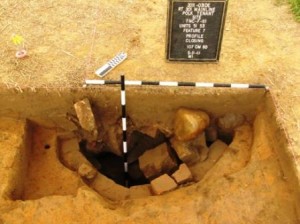

Facebook Twitter Flickr YouTube RSS Feed
Written on: July 24th, 2013 in Archaeology Updates, US301
Alternative Mitigation of the Polk Tenant Site (7NC-F-111)
Versar continues to collect information on previously excavated wells from all over the state of Delaware. Last month we reviewed more than 100 archaeology reports prepared for DelDOT over the last 30 years. That review found that at least 50 wells have been identified across the state as a result of archaeological research conducted in advance of highway improvements. Wells have been found on historical home sites, farmsteads, dairy farms, stores, and blacksmith shops dating from the mid-1600’s through mid-1900s. Materials used in the construction of these wells included wood timbers, barrels, stone, and brick. The wells consist of both square and round shafts, with round being the most common form. This month we will visit the Archives of the Division of Historical and Cultural Affairs in Dover. There Versar researchers will review reports from non-DelDOT sponsored archaeological investigations. We plan to examine reports conducted by other state agencies, federal agencies and the military, universities, or by volunteer community groups such as the Archaeological Society of Delaware.
To learn more about this site, visit: https://deldot.gov/environmental/archaeology/williams/index.shtml
Written on: July 11th, 2013 in I-95, I95/SR1 Interchange
The northbound I-95 to northbound Route-7 ramp was opened in May 2013.
Structural steel beams for the bridges was delivered throughout the spring and is all in place. Construction continues on the rest of the bridges, decks, overpasses, roadway paving, and retaining walls.
The project is about 80 % completed.
The northbound Route-1 to northbound I-95 flyover ramps and the southbound I-95 to southbound Route-1 flyover ramps will be opened during the Fall.
Written on: July 3rd, 2013 in Route 26
DelDOT’s self-imposed July 1 deadline for lane closures along SR26 has come and gone, and as planned utility companies have completed their scheduled work on time. This means that as of July 1, 2013 lane closures will no longer be required for overhead utility relocation work along Route 26. Overhead utility relocation work will continue through the summer, but without the need for lane closures. Delmarva Power and Verizon will continue to work on underground services, street light installation, moving facilities from old poles to new poles, and old pole removal. Thanks to the hard work of Delmarva Power, Verizon, Mediacom, and their sub-contractors, nearly half of the project’s utility relocation effort has been completed! DelDOT would like to congratulate Delmarva Power, Verizon, Mediacom and their sub-contractors on reaching this important milestone in the SR26 project. DelDOT would also like to thank the traveling public along Route 26 for their patience and understanding during this difficult operation.
Written on: July 1st, 2013 in Archaeology Updates, US301
Here is the location of the Polk Tenant Site on the 1868 Beers Atlas Map.

And a photograph of a partially excavated well at the Polk Tenant Site.

Written on: July 1st, 2013 in Archaeology Updates, US301
Update on the Dale African American archaeological site:
Samuel Dale’s Strange “Manumission,” 1854
The Samuel Dale who owned the Dale Site lived as a free man for most of his life. Born in 1791, he first appeared in the census as a free man in 1810. He was counted as a free man every ten years thereafter, all the way to 1870, shortly before his death. We were therefore shocked to find in the New Castle County deed book for 1854 an entry reading,
Know all men by these presents that I Nicholas Patterson of the City of Wilmington New Castle County and State of Delaware (Minister of the Gospel) from motives of benevolence and humanity, have manumitted and do manumit and set free from slavery my negro man Samuel Dale of St. Georges Hundred in the County and State aforesaid aged about forty years, he the said Samuel Dale having been the slave of James Haughey late of St. Georges Hundred decd who by his will gave the said Samuel Dale (among other things) to his children and the survivor of them, the only survivor of whom is Mrs. Eliza Patterson, formerly Eliza Haughey and now wife of the said Nicholas Patterson.
At first we thought that this must be some other Samuel Dale. After all, this document says Dale was about forty, and the owner of the Dale Site would have been about 65. So far as we can tell, though, the only other Samuel Dale living in St. Georges Hundred was the son of our Samuel Dale, who was younger than forty in 1854 and just as free as his father. We also know that our Samuel Dale was connected to the Haughey family, and that the land Dale bought once belonged to the Haugheys. Besides, until recently many older people had only a vague notion of their own ages. So the manumission must have been for the owner of the Dale Site.
But why was a manumission enrolled in 1854 for a 65-year-old man who had been living free for at least 44 years? Probably because of the other major event in Dale’s life that year, his purchase of the 20 acres of land that became his farm. Either when he proposed to buy the land, or when he tried to have the deed enrolled at the court house, somebody must have demanded proof that Dale was in fact a free man. If there ever was a written record of Dale’s manumission 44 years before, it had been lost. So Dale had to track down the only surviving daughter of his former master and persuade her husband to free him again, this time with proper documentation. Just one small sign of the difficulties faced by African Americans in the nineteenth century.
